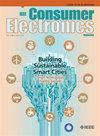A Resource Optimization Approach Based on Deep Integration of Vision-Motion System for Sustainable Agriculture
IF 10.9
2区 计算机科学
Q1 ENGINEERING, ELECTRICAL & ELECTRONIC
引用次数: 0
Abstract
The integration of vision and motion systems represents a critical phase in the intelligent transformation of consumer electronics aimed at enhancing productivity. However, owing to the operational modes and distributional characteristics inherent in existing systems, achieving large-scale, stable, and consistent agricultural applications on consumer electronics remains a significant challenge. To address this problem, this paper proposes a unified resource optimization approach for different configurations of agricultural consumer electronics to achieve deep integration of vision and motion systems. The optimization is mainly at two levels: on the one hand, we design a velocity observer for the vision-motion integrated system represented by the visual servoing system, which makes native changes to the characteristics of the visual servoing’s non-real-time instruction issuance. By converting long-time commands with uncertain period to short-time commands with certain period, the design difficulty of real-time trajectory planning of the real underlying motion controller is simplified. On the other hand, in image-based visual servoing (IBVS) system, the mixture parameter of the image Jacobian matrix also affect the control performance of the visual servoing system. For most IBVS-based agricultural applications, there is a lack of a systematic approach to ensure that the mixture parameter is adaptively and continuously varied. To solve this problem, this paper proposes a fuzzy logic-based method to adaptively adjust this parameter and ensure its continuity by introducing a suitable membership function. The experimental results of visual servoing based on the consumer electronics show that our proposed method can significantly improve the integrated vision-motion controllability, and can trade-off the convergence efficiency and feature retention constraints to effectively improve the overall efficiency of the system operation.基于视觉-运动系统深度集成的可持续农业资源优化方法
视觉和运动系统的集成代表了旨在提高生产力的消费电子产品智能转型的关键阶段。然而,由于现有系统固有的操作模式和分布特征,在消费电子产品上实现大规模、稳定和一致的农业应用仍然是一个重大挑战。针对这一问题,本文提出了一种针对农业消费电子产品不同配置的统一资源优化方法,实现视觉与运动系统的深度集成。优化主要有两个层面:一方面,我们为视觉伺服系统所代表的视觉-运动集成系统设计了速度观测器,对视觉伺服非实时指令发布的特点进行了原生改变;通过将不确定周期的长时间指令转换为确定周期的短时间指令,简化了真实底层运动控制器实时轨迹规划的设计难度。另一方面,在基于图像的视觉伺服系统中,图像雅可比矩阵的混合参数也会影响视觉伺服系统的控制性能。对于大多数基于ibvs的农业应用,缺乏一种系统的方法来确保混合参数自适应和连续变化。为了解决这一问题,本文提出了一种基于模糊逻辑的方法,通过引入合适的隶属函数来自适应调整该参数并保证其连续性。基于消费类电子产品的视觉伺服实验结果表明,该方法能够显著提高视觉运动的综合可控性,并且能够权衡收敛效率和特征保留约束,有效提高系统的整体运行效率。
本文章由计算机程序翻译,如有差异,请以英文原文为准。
求助全文
约1分钟内获得全文
求助全文
来源期刊
CiteScore
7.70
自引率
9.30%
发文量
59
审稿时长
3.3 months
期刊介绍:
The main focus for the IEEE Transactions on Consumer Electronics is the engineering and research aspects of the theory, design, construction, manufacture or end use of mass market electronics, systems, software and services for consumers.

 求助内容:
求助内容: 应助结果提醒方式:
应助结果提醒方式:


